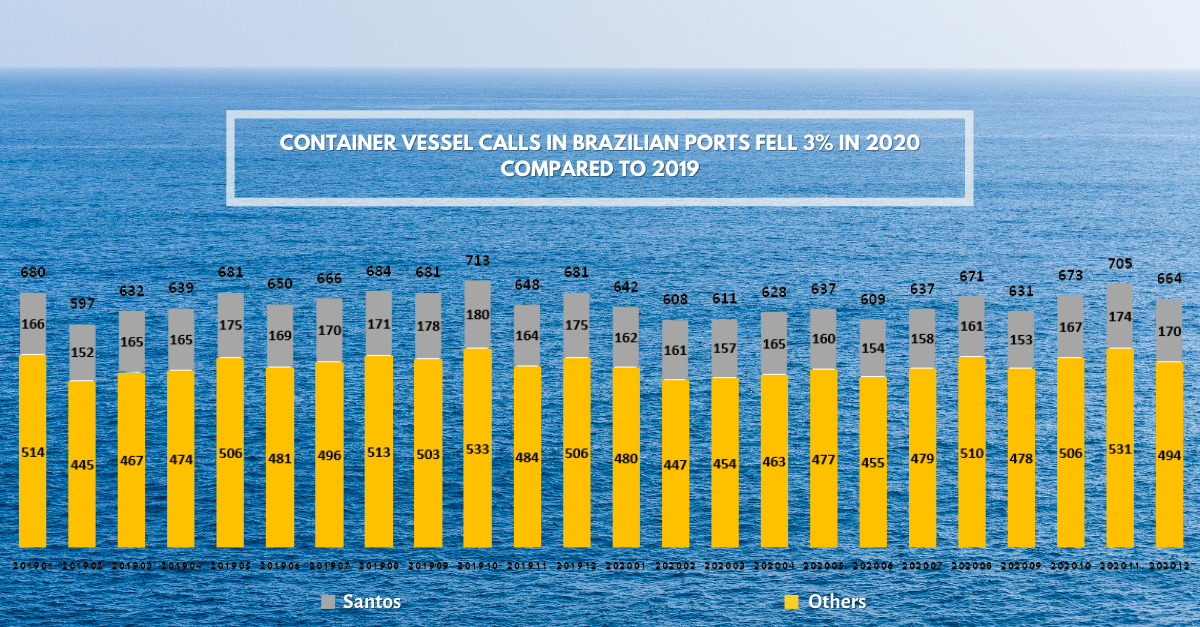
Container vessel calls in Brazilian ports drop 3% in 2020 compared to 2019
Jan, 05, 2021 Posted by Ruth HollardWeek 210101
Container vessel calls in Brazilian ports are indicative of the country’s economic activity. Therefore, the Datamar team gathered some data that can act as a thermometer of the atypical year of 2020.
In December 2020, the country registered 664 container vessel calls at its ports, a decrease of 2.5% in relation to the same month of 2019. In Santos, the decrease was slightly greater, -2.85%. In comparison with November 2020, the vessel calls fell 5.8%.
But despite the effects of the Covid-19 pandemic on economic activity, Brazilian ports recorded a drop of only 3% in container vessel calls in 2020 compared to 2019. The Port of Santos registered a drop of 4% in the period.
Container Vessel Calls in Brazilian Ports | Jan 2019 to Dec 2020 per week
Source: DataLiner
The table below shows the number of container vessel calls in each Brazilian port in 2020 and a comparison with 2019. Most ports registered a drop in berthing. The year was very good for agribusiness, and grain exports even broke records, but container handling was less than in 2019 in most ports. The positive highlight was the Port of Navegantes, which grew 8%.
The growth of moorings at Port of Itaqui is due to the fact that in August 2019, a testing phase for a regular service began, which was initiated in February 2020.
Container Vessel Calls in Brazil by Port | Jan to Dec 2019-2020
Source: DataLiner (To request a DataLiner demo click here)
According to Portonave, the result of the Port of Navegantes reflects a sum of factors, driven by the resumption of economic growth; Brazil’s GDP in the third quarter closed at + 7.7%. Even with the world pandemic scenario, the port sector did not stop, and proved to be essential, both for supplying industries and inputs for domestic consumption and for sending products and raw materials to other countries. Imports, which fell at the beginning of the pandemic until the middle of the year, have recovered in recent months. In November alone, the Port of Navegantes had six extra vessel calls.
The completion of the first phase of the New Evolution Basin, which makes it possible for the ports of Itajaí and Navegantes to receive ships up to 350 meters in length, was one of the factors that contributed to the growth in movement as well. Since May, more than 40 ships over 306m in length have turned in the new maneuver space. The construction required the united efforts of the port authority, navy, pilotage, and state government to be executed.
Another port that had increased container movement was Paranaguá, which registered 3% more moorings in 2020 compared to 2019. According to Portos do Paraná, the ports of the state closed the year setting fifteen new records, including: the record movement of more than 55 million tons of cargo handled, the largest number of trucks received at the sorting yard, the largest grain ship ever received, among others. These made the ports of Paranaguá and Antonina stand out in the national sector.
“Despite the health crisis, the ports of Paraná advanced. The state had a spectacular soybean harvest and the price of the product in the international market favored exports. In addition, sugar was very prominent, as were frozen chicken and vegetable oil ”, comments the CEO of Portos do Paraná, Luiz Fernando Garcia.
In addition, in December, the port authority announced that the Port of Paranaguá can now load another 120 full containers, per ship, in the last two berths east of the public pier: 217 and 218. This is true for large vessels in the segment, which measure over 300 meters in length. The increase means 15% more handling capacity.
“This was possible because the maritime authority has just approved another 30 centimeters of operational draft for these two berths. We went from 11.80 meters to 12.10 meters “, highlights Luiz Fernando Garcia. The operational draft is the measure that goes from the water surface line to the bottom of the ship (keel).” This measure directly reflects the capacity that the ships have to load. This is how far they can sink when loaded ”, simplifies Garcia.
Considering the evolution of the operational draft, in the last five years, the container terminal at the Port of Paranaguá increased the handling capacity, by ship, by an additional 1,280 TEU. The operational draft gain obtained from 2015 until this last revision is 1.60 meters.
For 2021, the question is how the second wave of Covid-19 and the vaccine against the disease will affect the Brazilian and world economies. There is no forecast for blank sailing for the month of January.
-
Trade Regulations
Mar, 10, 2023
0
Brazil, Australia open talks for agricultural trade agreements
-
Ports and Terminals
Aug, 31, 2023
0
Port authority wins licitation dispute concerning leases in Paranagua Port
-
Grains
Aug, 05, 2024
0
Revenue from grain exports in Argentina increases 35.8% in July
-
Meat
Oct, 07, 2024
0
Brazil Risks Losing Ground in Canadian Chicken Market to Chile, USDA Warns

